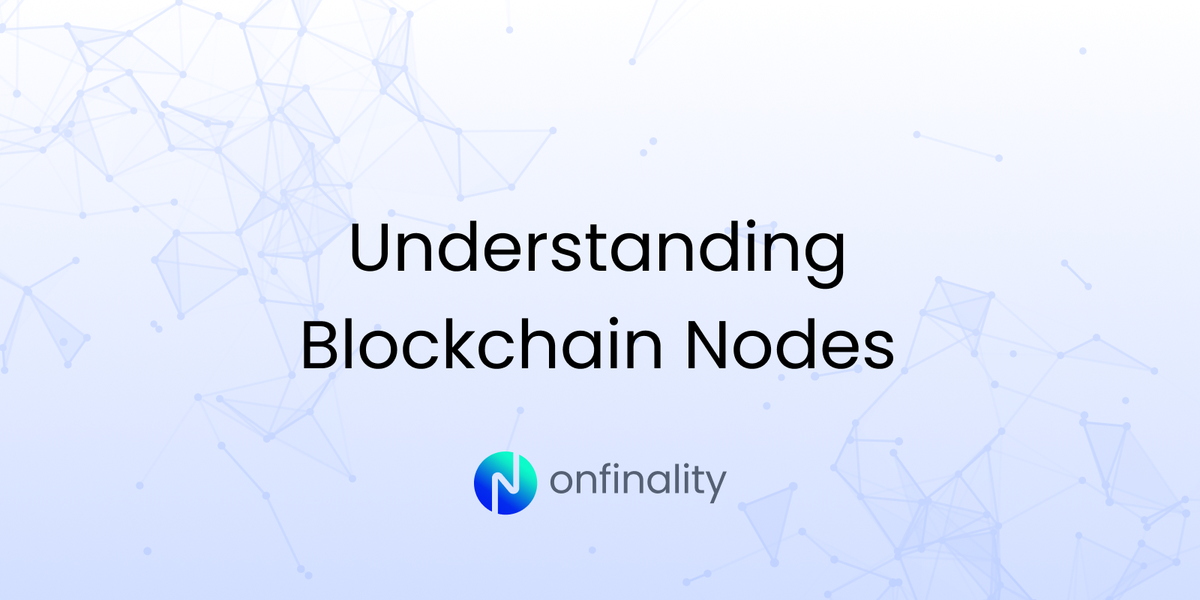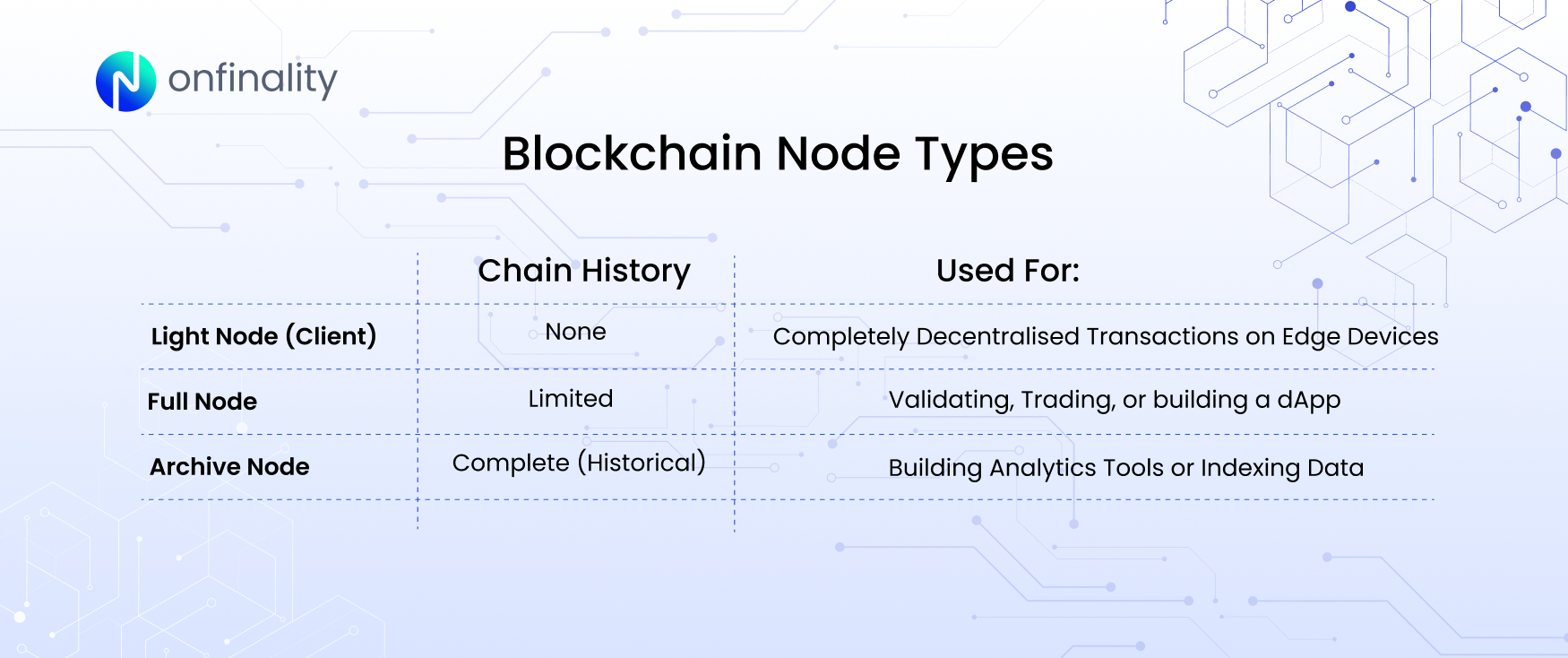Understanding Blockchain Nodes: Full Node, Archive, and Light Explained
Blockchain networks rely on nodes - the distributed computers that validate, store, and transmit transactions. Without them, no blockchain could exist. In this article, we’ll break down what a blockchain node is, the key blockchain node types (full, archive, and light)

Blockchain networks rely on nodes — the distributed computers that validate, store, and transmit transactions. Without them, no blockchain could exist. In this article, we’ll break down what a blockchain node is, the key blockchain node types (full, archive, and light), and how developers can easily deploy their own blockchain node using professional infrastructure providers.
What Is a Node in Blockchain?
A node in a blockchain is any computer connected to the network that stores, verifies, or relays blockchain data. Nodes form the backbone of decentralization - they maintain copies of the ledger, enforce consensus rules, and ensure transparency across the network.
Depending on their role and the amount of data they store, nodes can be categorized into several types.
📘 Reference: Ethereum.org: Nodes and Clients
Blockchain Node Types Explained

Full Node
A full node stores the entire blockchain’s transaction history and verifies every block and transaction against the consensus rules. It ensures the network remains secure, consistent, and censorship-resistant.
Use Cases:
- Wallet providers needing verified on-chain data
- dApp developers requiring reliable transaction validation
- Validators maintaining network security
Pros:
- Access to important current state data such as wallet balances
- Some recent transactions available
- Cost efficient with smaller storage requirements
Cons:
- Does not have full history of all transactions
Archive Node
An archive node stores everything a full node does, plus the complete historical state of the blockchain at every block height. This makes it invaluable for historical queries and analytical workloads.
Use Cases:
- Blockchain explorers and indexers
- DeFi protocols analyzing on-chain history
- Research and compliance teams
Pros:
- Access to historical balances, states, and contract variables
Cons:
- Heavy storage requirements (often several terabytes)
Light Node
A light node (or lightweight client) downloads only block headers and relies on full nodes for complete transaction data. It uses cryptographic proofs to verify block validity without needing the full chain.
Use Cases:
- Mobile and browser-based wallets
- IoT or resource-limited blockchain applications
Pros:
- Truly Decentralised: Can be run directly from the dApp (browser or wallet) removing the need for third party service providers
- Fast sync times and low storage requirements
- Ideal for lightweight or mobile environments
Cons:
- Depends on full nodes for complete transaction details
- Can have lower performance
📗 Reference: Ethereum Light Clients
Comparative Overview
Choosing the Right Node
Your ideal node type depends on your technical and operational goals:
- Running a validator, trading, or building a dApp? → Use a Full Node.
- Building analytics or indexing data? → Choose an Archive Node.
- Creating a fully decentralised wallet? → A Light Node is the way to go.
Blockchain Node Hosting Made Simple
Setting up and maintaining a blockchain node can be complex — from managing hardware to ensuring uptime and performance. That’s why many developers now use managed node hosting platforms that offer instant access to full and archive nodes across multiple networks.
Providers like OnFinality make it simple to:
- Deploy blockchain nodes in minutes
- Access reliable RPC endpoints for hundreds of networks
- Scale globally with built-in monitoring and maintenance
🚀 Start building today - deploy your blockchain node with OnFinality
Common Questions About Blockchain Nodes
What is the difference between a full node and an archive node?
A full node gives your app current blockchain data for validation, while an archive node lets your app access the entire history for deep queries and analytics.
How do crypto nodes work?
Crypto nodes maintain the blockchain network by storing a copy of the ledger, verifying new transactions, and relaying them to other nodes. They follow consensus rules to ensure the network is accurate, secure, and decentralized. Some nodes, like validators, also propose new blocks, while light nodes rely on full nodes to validate data.
What is the difference between a node and a miner?
A node is any network participant that stores and validates blockchain data. A miner (or validator, depending on the blockchain) is a specialized node that also competes to create new blocks, earning rewards for their work. All miners are nodes, but not all nodes are miners.
Final Thoughts
Every blockchain relies on its nodes to maintain integrity, security, and accessibility. Whether you’re developing a new dApp, analyzing chain data, or running validator infrastructure, understanding the difference between full, archive, and light nodes helps you choose the right tool for the job.
To skip the complexity of setup and maintenance, use a trusted provider to deploy your node — and focus on what matters most: building the future of Web3.
👉 Deploy your blockchain node with OnFinality
About OnFinality
OnFinality is a blockchain infrastructure platform that saves web3 builders time and makes their lives easier. OnFinality delivers scalable API endpoints, nodes, AI Agents, and indexers for the biggest blockchain networks and empowers developers to automatically test, deploy, scale and monitor their own blockchain nodes in minutes.
To date, OnFinality has served hundreds of billions of RPC requests, supports over 125 networks including Avalanche, BNB Chain, Cosmos, Polkadot, Ethereum, and Polygon, and is continuously expanding these mission-critical services so developers can build the decentralised future, faster!
